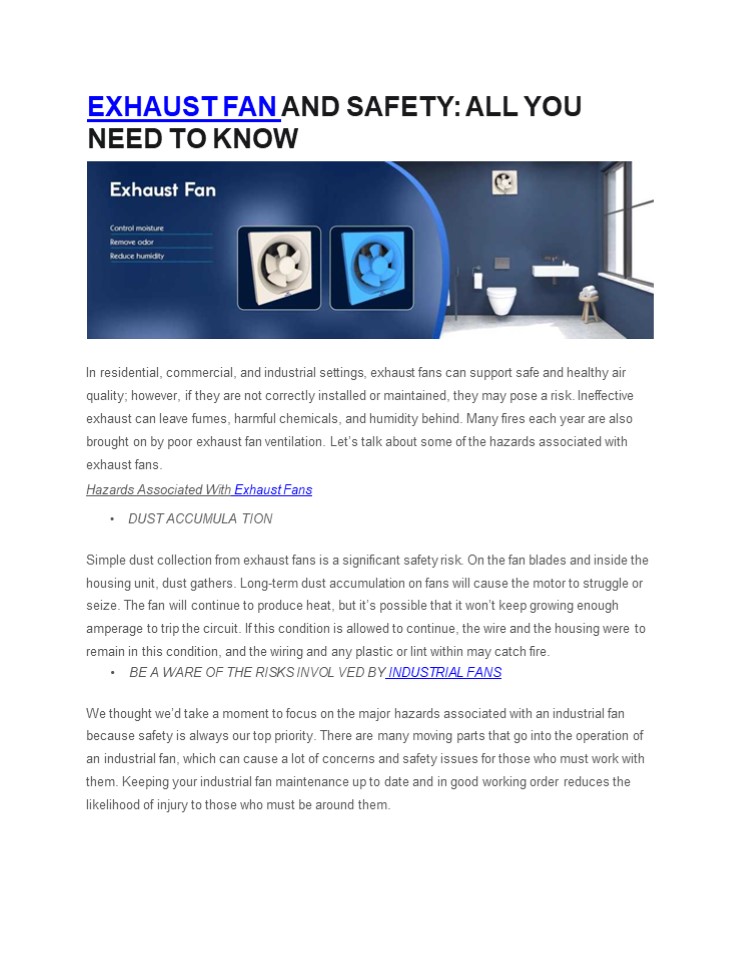EXHAUST FAN AND SAFETY: ALL YOU NEED TO KNOW - PowerPoint PPT Presentation
Title:
EXHAUST FAN AND SAFETY: ALL YOU NEED TO KNOW
Description:
In residential, commercial, and industrial settings, exhaust fans can support safe and healthy air quality; however, if they are not correctly installed or maintained, they may pose a risk. Ineffective exhaust can leave fumes, harmful chemicals, and humidity behind. Many fires each year are also brought on by poor exhaust fan ventilation. Let’s talk about some of the hazards associated with exhaust fans. – PowerPoint PPT presentation
Number of Views:2
Title: EXHAUST FAN AND SAFETY: ALL YOU NEED TO KNOW
1
EXHAUST FAN AND SAFETY ALL YOU NEED TO KNOW
In residential, commercial, and industrial
settings, exhaust fans can support safe and
healthy air quality however, if they are not
correctly installed or maintained, they may pose
a risk. Ineffective exhaust can leave fumes,
harmful chemicals, and humidity behind. Many
fires each year are also brought on by poor
exhaust fan ventilation. Lets talk about some of
the hazards associated with exhaust fans. Hazards
Associated With Exhaust Fans DUST ACCUMULA
TION Simple dust collection from exhaust fans is
a significant safety risk. On the fan blades and
inside the housing unit, dust gathers. Long-term
dust accumulation on fans will cause the motor to
struggle or seize. The fan will continue to
produce heat, but its possible that it wont
keep growing enough amperage to trip the circuit.
If this condition is allowed to continue, the
wire and the housing were to remain in this
condition, and the wiring and any plastic or lint
within may catch fire. BE A WARE OF THE
RISKS INVOL VED BY INDUSTRIAL FANS We thought
wed take a moment to focus on the major hazards
associated with an industrial fan because safety
is always our top priority. There are many moving
parts that go into the operation of an industrial
fan, which can cause a lot of concerns and safety
issues for those who must work with them. Keeping
your industrial fan maintenance up to date and in
good working order reduces the likelihood of
injury to those who must be around them.
2
BATHROOM EXHAUST FAN FIRE HAZARDS
Exhaust fans are found in most residences and
many commercial properties to help prevent
steamed-up mirrors, damp walls, and fogged
windows along with removing odors. However, they
can also present a potential fire hazard if not
cleaned and maintained on a regular basis. Fans,
over time, build up lint which can cause the
motor to overheat and ignite the lint, plastic
fan blades, and the nearby combustible wood
structure. The speed at which the lint builds up
is a function of the amount of use and the amount
of particulate in the air in which it operates.
Safety Measures For Safety
MAINTENANCE SCHEDULE Maintain a maintenance
schedule to prevent mishaps brought on by exhaust
fan accumulation. Switch off the circuit breaker,
then clean the fan motor and blades at
predetermined intervals (these will vary
depending on the fan use). A professional should
clean vent fans in commercial and industrial
buildings. SEPARA TE INPUT AND OUTPUT
VENTS Additionally, improper exhaust location can
provide a risk to safety. Indoor air might become
contaminated if an exhaust fan is vented too near
an air intake vent. Separate the air intake and
vents, and place the intake vents far from other
pollutant sources. MAXIMIZE PERFORMAN To
maximize performance, outdated exhaust systems
and fans may need to be upgraded or replaced to
make the most of home, commercial, or industrial
ventilation.
3
7 Most Effective Tips to Prevent Exhaust Fan
Hazards
1. Keep children and/or persons with reduced
physical, sensory or mental capabilities away
from the fan. 2. Never insert fingers or
objects through the guards. 3. Never leave the
running fan unattended. 4. Never operate
without ALL guards in place, including inlets and
discharge guards/grills. 5. Do not use in a
confined space as this could cause injury or
death by asphyxiation? 6. Do not use inside a
tank or confined area that contains, or did
contain any volatile fumes, gases, or liquids. 7.
Do not locate in a corrosive atmosphere or
where ambient temperature will exceed 40 C. Do
not exhaust any air, gas, or fumes that can
exceed 66 C.
Keep these safety measures and tips in mind to
avoid any kind of hazard in your life. Feel free
to contact us for any further assistance of
electrical appliances.































